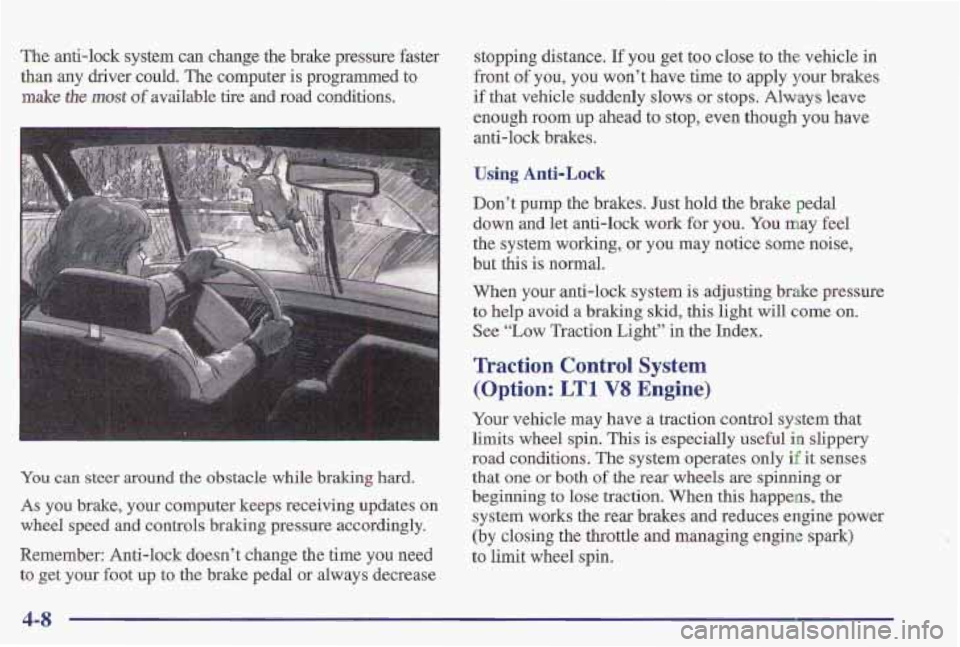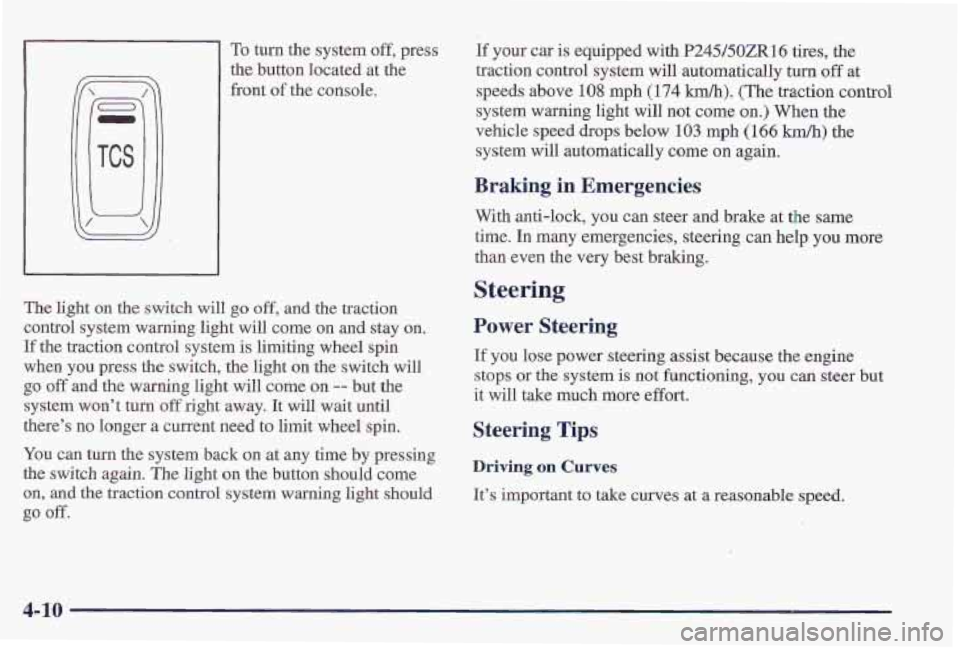1997 PONTIAC FIREBIRD brake light
[x] Cancel search: brake lightPage 128 of 410

Voltmeter
You can read battery
voltage on your voltmeter.
If it reads less than 11 volts
or more than
16 volts while
your engine is running, and
it stays there, you may have
a problem with the
electrical charging system.
Brake System Warning Light
Your Pontiac’s hydraulic brake system is divided into
two parts.
If one part isn’t working, the other part can
still work and stop you.
For good braking, though, you
need both parts working well.
If the warning light comes on, there could be a brake
problem or the brake fluid level could
be low. Have your
brake system inspected right away.
Have it checked right away. Driving with the voltmeter
reading in a warning zone could drain your battery.
If you idle your engine for a while, the voltmeter
reading might move into the yellow zone.
If the reading
stays in the yellow zone while you are driving, you may
have a problem with the electrical charging system.
Have
it checked. While the voltmeter reads in the yellow
zone, your battery may not be able to power certain
electrical accessories, like
ABS. (If this happens, your
ABS INOP light will come on. See “Anti-Lock Brake
System Warning Light” in this part.)
If you must drive a short distance with
the voltmeter
reading in
a warning zone, turn off all your accessories,
including your air conditioning and audio system.
BRAKE
This light should come on
briefly when you turn
the ignition key to
RUN. If
it doesn’t come on then,
have it fixed
so it will be
ready to warn you if there’s
a problem.
If the light comes on while you are driving, pull off the
road and stop carefully.
You may notice that the pedal is
harder to push. Or, the pedal may
go closer to the floor.
It may take longer to stop. If the light is still on, or if the
anti-lock brake system warning light is flashing, have
the vehicle towed for service. (See “Anti-Lock Brake
Page 129 of 410

System Warning Light” and “Towing Your Vehicle” in Anti-Lock 1- System Warning Eight
the Index.)
Your braKe s cem may not be working properly
if the brake system warning light is on. Driving
~ with the brake system warning light on can lead
to an accident.
If the light is still on or if the
anti-lock brake system warning light
is flashing
after
you’ve pulle’d of€ the road and stopped
~
!
ABS
INOP
With the anti-lock brake
system, this light will come
on when you start your
engine and it will stay
on for three seconds.
That’s normal.
carefully, have the vehicle towed for service. If the light flashes when you’re driving, you don’t have
anti-lock brakes and there could be
a problem with your
regular brakes. Pull off the road and stop carefully. You
When the ignition is on* the brake system warning light may notice that the pedal is harder to push. or, the pedal
on when YOu set Your Parking brake* The may go closer to the floor, It may take longer to stop,
light will stay
on if your parking brake doesn’t release Have the vehicle towed for service. (See “Towing Your
fully.
If it stays on after your parking brake is fully Vehicle” in the Index.)
released, it means you have
a brake problem.
2-80
Page 130 of 410

Traction Control System Warning Light
(If Equipped)
I
Your regular brake system may not be working
properly if the anti-lock brake system warning
light is flashing. Driving with the anti-lock
brake system warning light flashing can lead to
an accident. After you’ve pulled off the road
and stopped carefully, have the vehicle towed
for service.
If the anti-lock brake system warning light stays on
longer than normal after you’ve started your engine, turn
the ignition off. Or, if the light comes on and stays on
when you’re driving, stop as soon as possible and turn
the ignition off. Then start the engine again to reset the
system.
If the light still stays on, or comes on again
while you’re driving, your Pontiac needs service. If the
light is on but not flashing and the regular brake system
warning light isn’t on, you still have brakes, but you
don’t have
anti-lock brakes.
The anti-lock brake system warning light should come
on briefly when you turn the ignition key to RUN. If the
light doesn’t come on then, have it fixed so it will be
ready to warn you if there is a problem.
TCS
OFF
This warning light should
come on briefly as you start
the engine.
If the. warning
light doesn’t come on then,
have it fixed
so it will be
ready to warn you if there’s
a problem.
If it stays on, or comes on when you’re driving, there
may be a problem with your traction control system and
your vehicle may need service. When this warning light
is on, the system will not limit wheel spin. Adjust your
driving accordingly.
If your brakes begin to overheat, the brake portion of the
traction control system will shut down, but the throttle
and engine spark control will continue
to work. The
warning light will not come on when this happens.
Page 131 of 410

The traction control system warning light may come on
for the following reasons:
If you turn the system off by pressing the switch
located at the front
of the console the warning light
will come on and stay on and the light on the switch
will
go out. To turn the system back on, press the
switch again. The warning light should go off.
(See “Traction Control System” in the Index
for more information.)
If the temperature of the throttle control b’egins to
rise, the system will turn off and the warning light
will come
on until the system cools down. The
system does this to prevent damage from
overheating.
If the traction control system warning light comes on
and stays on for an extended period
of time when the
system
is turned on, your vehicle needs service.
Low Traction Light
When your anti-lock system
is adjusting brake pressure
to help avoid
a braking skid,
this light will come on.
LOW
TRAC
If you have the traction control system, this light will
also come
on when the system is limiting wheel spin.
Slippery road conditions may exist if the low traction
light comes on,
so adjust your driving accordingly. The
light will stay on for a few seconds after the anti-lock
system stops a’djusting brake pressure or the traction
control system stops limiting wheel spin.
The low traction
light also comes on briefly when you
turn the ignition
key to RUN. If the light doesn’t come
on then, have
it fixed so it will be there to tell you when
the anti-lock brake system or traction control system
is active.
2-82
Page 172 of 410

Anti-Lock Brakes (ABS)
Your vehicle has anti-lock brakes (ABS). ABS is an
advanced electronic braking system that will help
prevent a braking skid.
When you start your engine, or when you begin to drive
away, your anti-lock brake system will check itself.
You
may hear a momentary motor or clicking noise while
this test is going on, and you may even notice that your
brake pedal moves a little. This is normal.
ABS
INOP
If there’s a problem with the
anti-lock brake system, this
warning light will stay
on or
flash. See “Anti-Lock
Brake System Warning
Light” in the Index.
Here’s how anti-lock works. Let’s say the road
is wet.
You’re driving safely. Suddenly an animal jumps out in
front of you.
You slam on the brakes. Here’s what happens with
ABS.
A computer senses that wheels are slowing down. If one
of the wheels is about to st,op rolling, the computer will
separately work the brakes at each front wheel and at
the
rear wheels.
4-7
Page 173 of 410

The anti-lock system can change the brake pressure faster
than any driver could. The computer is programmed to
make the most of available tire and road conditions.
You can steer around the obstacle while braking hard.
As you brake, your computer keeps receiving updates on
wheel speed and controls braking pressure accordingly.
Remember: Anti-lock doesn’t change the time
you need
to get your foot up to the brake pedal or always decrease stopping distance.
If you
get too close to the vehicle in
front
of you, you won’t have time to apply your brakes
if that vehicle suddenly slows or stops. Always leave
enough room up ahead to stop, even though you have
anti-lock brakes.
Using Anti-Lock
Don’t pump the brakes. Just hold the brake pedal
down and let anti-lock work for you.
You may feel
the system working, or you may notice some noise,
but this is normal.
When your anti-lock system
is adjusting brake pressure
to help avoid a
braking skid, this light will come on.
See
“Low Traction Light” in the Index.
Traction Control System
(Option: LTI V8 Engine)
Your vehicle may have a traction control system that
limits wheel spin. This
is especially useful in slippery
road conditions. The system operates only
if it senses
that one or
both of the rear wheels are spinning or
beginning to lose traction. When this happens,
the
system works the rear brakes and reduces engine power
(by closing the throttle and managing engine spark)
to limit wheel spin.
Page 175 of 410

To turn the system off, press
the button located at the
front
of the console.
The light on
the switch will go off, and the traction
control system warning light will come on and stay on.
If the traction control system is limiting wheel spin
when
you press the switch, the light on the switch will
go off and the warning light will come on -- but the
system won’t turn
off right away. It will wait until
there’s
no longer a current need to limit wheel spin.
You can turn the system back on at any time by pressing
the switch again. The light
on the button should come
on, and the traction control system warning light should
go off. If
your car is equipped with P245/5OZR16 tires, the
traction control system will automatically turn
off at
speeds above 108 mph
(174 km/h). (The traction control
system warning light will not come on.) When the
vehicle speed drops below
103 mph (166 kmh) the
system will automatically come on again.
Braking in Emergencies
With anti-lock, you can steer and brake at the same
time.
In many emergencies, steering can help you more
than even the very best braking.
Steering
Power Steering
If you lose power steering assist because the engine
stops or the system is not functioning, you can steer but
it will take much more effort.
Steering Tips
Driving on Curves
It’s important to take curves at a reasonable speed.
4- 10
Page 183 of 410

Driving too fast through large water puddles or even
going through some
car washes can cause problems, too.
The water may affect your brakes. Try to avoid puddles.
But if you can’t, try to slow down before you hit them.
Wet brakes can cause accidents. They won’t work
as well in
a quick stop and may cause pulling to
one side. You could lose control of the vehicle.
After driving through a large puddle of water or
a car wash, apply your brake pedal lightly until
your brakes work normally.
4-18